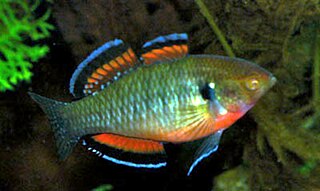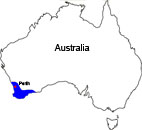
The Sacramento perch is an endangered sunfish native to the Sacramento–San Joaquin River Delta, Pajaro, and Salinas River areas in California, but widely introduced throughout the western United States.

Threatened fauna of Australia are those species and subspecies of birds, fish, frogs, insects, mammals, molluscs, crustaceans, and reptiles to be found in Australia that are in danger of becoming extinct. This article lists species classified as threatened species under the Commonwealth Environment Protection and Biodiversity Conservation Act 1999.

The pirate perch is a freshwater fish that commonly inhabits coastal waters along the east coast of the United States and the backwater areas of the Mississippi Valley. This species is often found towards the bottom of clear, warm water habitats with low currents. These fish are normally solitary, carnivorous, and nocturnal. The pirate perch is known to consume live mosquito larva, amphipods, glass shrimp, meal worms, small fish, dragonfly and stonefly larvae, and earthworms.

The Australian smelt is a small, pelagic silvery freshwater fish found in large numbers in waters of the south eastern Australian mainland.
The Yarra pygmy perch is a species of temperate perch endemic to Australia. It occurs in the coastal drainages of southeastern Australia, preferring streams and lakes with plentiful vegetation and flowing water. It feeds on small insects and their larvae, as well as small crustaceans. This species can reach a total length of 7.5 cm (3.0 in), though most only reach about 5 cm (2.0 in). Yarra pygmy perch are olive-green above, greenish-brown on the sides, and yellowish-white below, with chevron-shaped markings on rear half of the body. It can also be found in the aquarium trade.
Nannoperca or pygmy perch is a genus of temperate perches endemic to freshwater systems of Australia.

Nannoperca oxleyana, commonly known as the Oxleyan pygmy perch, is a species of temperate perch endemic to Australia. It occurs in the coastal drainages of eastern Australia, being found in dune lakes, ponds, creeks, and swamps with plentiful vegetation to provide shelter. The waters in which it lives are often dark and acidic. It preys upon aquatic insects and their larvae, as well as planktonic crustaceans and even algae. This species can reach 7.5 cm (3.0 in) SL, though most do not exceed 4 cm (1.6 in). It can also be found in the aquarium trade.
The golden pygmy perch is a species of temperate perch endemic to Australia, where it is found in both Ewens Ponds and Deep Creek, South Australia, and several tributaries of the Glenelg River in Victoria. It prefers flowing water of ponds or small streams, generally being more commonly found in the streams that connect to the ponds, with plentiful vegetation or debris to provide shelter. It preys on extremely small crustaceans and aquatic insects. This species can reach 6.5 cm (2.6 in) SL. It can also be found in the aquarium trade.

The oriental dwarf kingfisher, also known as the black-backed kingfisher or three-toed kingfisher, is a pocket-sized bird in the family Alcedinidae. This tropical kingfisher is a partial migrant that is endemic across much of the Indian Subcontinent and Southeast Asia. It resides in lowland forests, typically near streams or ponds, where it feeds upon insects, spiders, worms, crabs, fish, frogs, and lizards. This small bird is easily distinguishable from other birds in its range due to its red bill, yellow-orange underparts, lilac-rufous upperparts, and blue-black back.

Agassiz's perchlet, also known as Agassiz's glass fish and the olive perchlet, is a species of ray-finned fish in the family Ambassidae. It is semi-transparent with dark scale edges forming a pattern over most of the body. It grows to a maximum of 7.5 cm. It is a macrophyte spawner with adhesive eggs. It is endemic to Australia. It was named for the zoologist Louis Agassiz.
The honey blue-eye is an endangered species of fish in the subfamily Pseudomugilinae. It is endemic to southeastern Queensland, Australia, where it is found in mildly acidic, often tannin-stained, ponds and streams in wallum habitat.

The banded pygmy sunfish, Elassoma zonatum, is a species of pygmy sunfish endemic to the United States, where it is found from Indiana and Illinois to Texas to the Atlantic coast. It prefers densely vegetated bodies of slow-moving water. This species can reach 4.7 cm (1.9 in) in total length, though most do not exceed 3.5 cm (1.4 in).
The stripetail darter is a species of freshwater ray-finned fish, a darter from the subfamily Etheostomatinae, part of the family Percidae, which also contains the perches, ruffes and pikeperches. It is endemic to the eastern United States. It is found in small rivers and streams in the states of Tennessee, Ohio, Kentucky, Illinois, Alabama, Georgia, and Mississippi. Males are a golden-orange color with black barring on the fins, and grow to a length of about 2.8 in (7 cm). This fish feeds on midge larvae and other small invertebrates. It breeds in the spring; eggs are attached to the substrate, often under slab rocks, where they are guarded by the male. The population trend of this fish seems to be stable and it is a common species with numerous sub-populations over a wide range, and the International Union for Conservation of Nature has assessed its conservation status as being of "least concern".
The wounded darter is a species of freshwater ray-finned fish, a darter from the subfamily Etheostomatinae, part of the family Percidae, which also contains the perches, ruffes and pikeperches. It is endemic to the eastern United States. Its range includes the upper Tennessee River drainage, western Virginia, western North Carolina, and eastern Tennessee. Its typical habitat is among boulders or coarse rubble and cobble, often with overhanging ledges, in medium to large slow-moving rivers. It feeds on small insect larvae, especially midge larvae. Spawning occurs when the water warms up in late spring. Females deposit clutches of adhesive eggs on the underside of rock ledges or slabs, and the male guards the nest. The population trend of this fish seems to be decreasing slowly but it is a relatively common species with numerous sub-populations, and the International Union for Conservation of Nature has assessed its conservation status as being of "least concern". The greatest threat comes from impoundment, and a management plan is in place, including captive breeding.

The ornate rainbowfish is a species of rainbowfish endemic to an area in eastern Australia, where it is native to coastal regions and sandy offshore islands in southern Queensland and northern New South Wales. It is the only known member of its genus. It is a popular aquarium fish.

Leiopotherapon unicolor, the spangled grunter or spangled perch is a species of ray-finned fish, a grunter from the family Terapontidae. It is endemic to Australia.

Hypseleotris compressa, the empire gudgeon, is a species of Gobiiform fish in the family Eleotridae endemic to Australia and south-central New Guinea.

The southern pygmy perch, also known as the Tasmanian pygmy perch, is a species of freshwater ray-finned fish, a temperate perch from the family Percichthyidae which is native to south-eastern Australia and Tasmania.
The little pygmy perch is a freshwater ray finned fish, a temperate perch from the family Percichthyidae endemic to southwestern Western Australia. It is known from just four sites in the Denmark catchment. It is found in tannin stained, acidic and shallow streams in woodland dominated by Melaleuca rhaphiophylla.
The lipstick darter is a species of freshwater ray-finned fish, a darter from the subfamily Etheostomatinae, part of the family Percidae, which also contains the perches, ruffes and pikeperches. It is endemic to the eastern United States, where it occurs in the Tallapoosa River drainage above the Fall Line in Alabama and Georgia. It inhabits rocky riffles of creeks and small to medium rivers.
















